#the yuppie handbook
Explore tagged Tumblr posts
Text
@caelums-fate
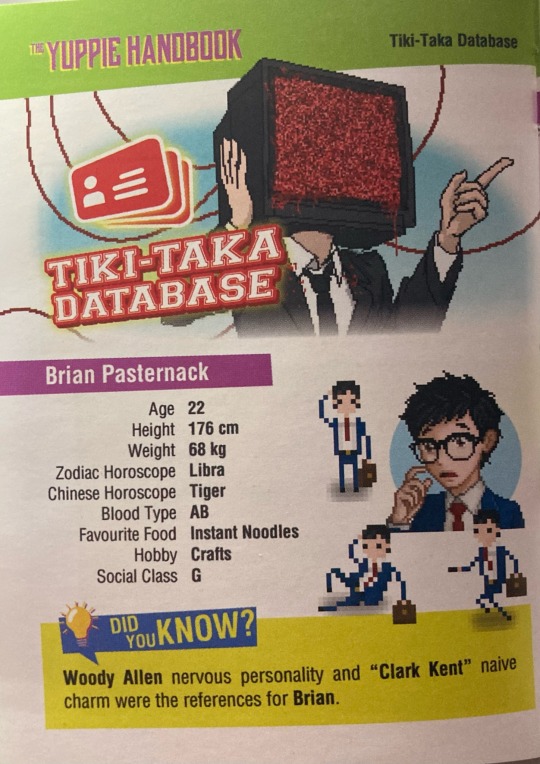
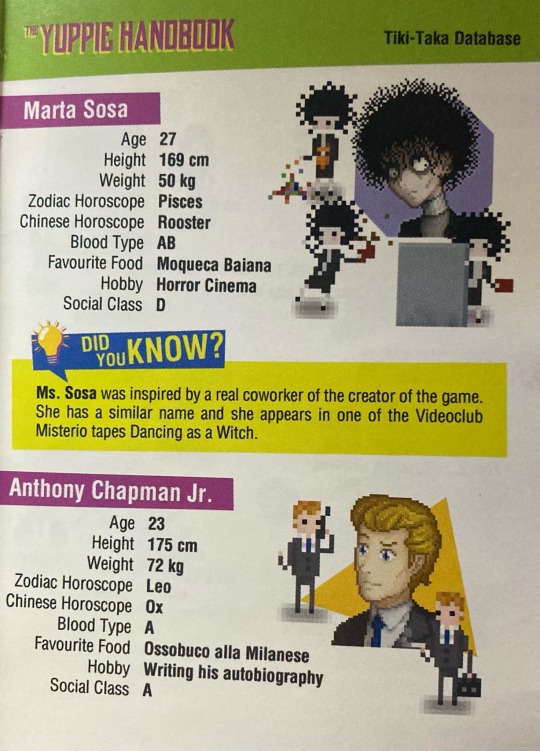
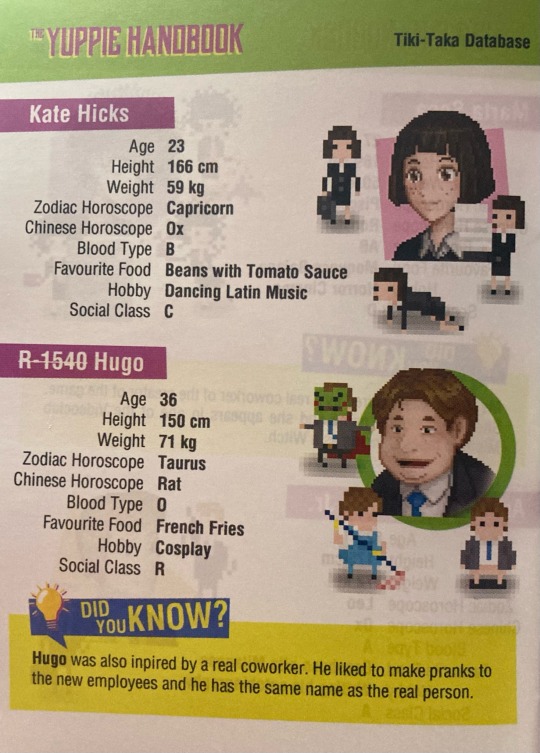

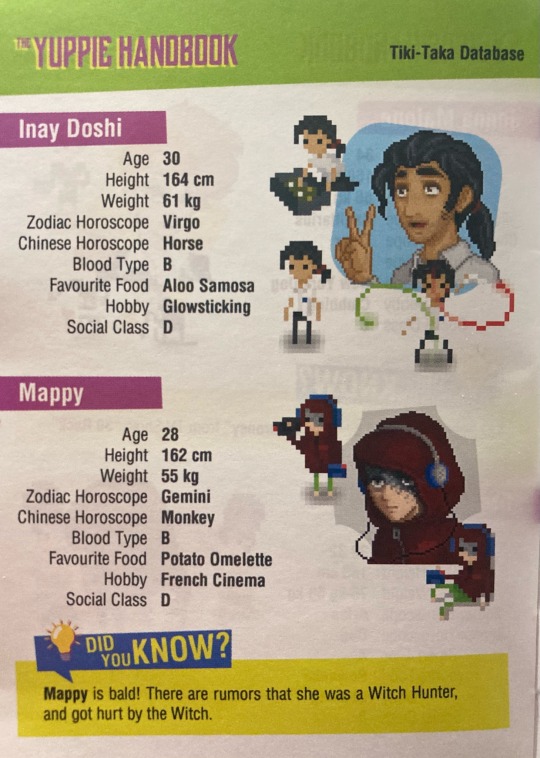
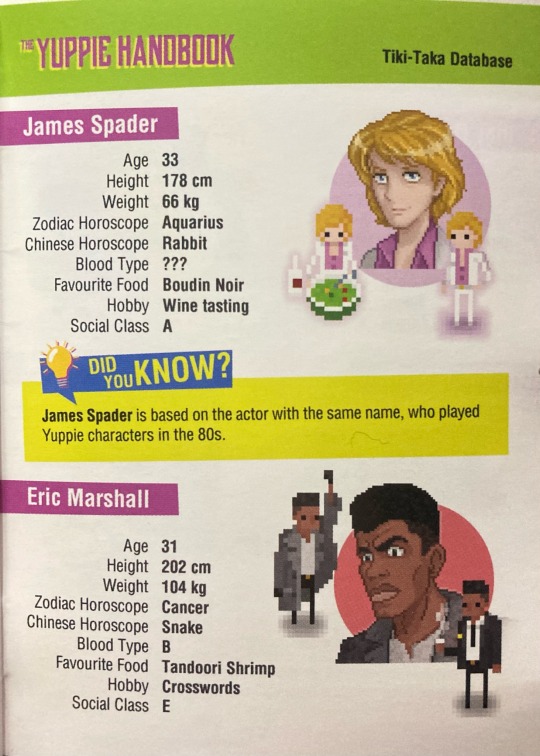
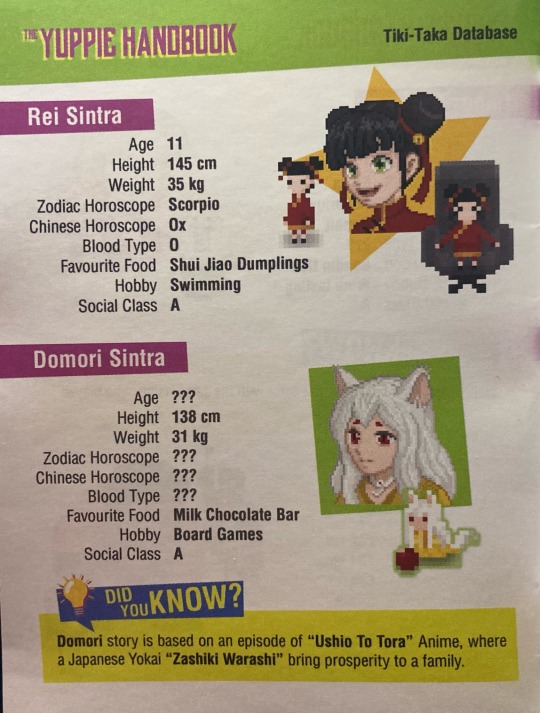
The Yuppie Handbook (Part 6) Tiki-Taka Database
#these seem interesting#yuppie psycho#brian pasternack#marta sosa#ms. sosa#anthony chapman jr.#mr. chapman#kate hicks#mr. hugo#super toad#jenna malone#ms. malone#irina rostov#ms. rostov#inay doshi#mr. doshi#mappy#james spader#spader#eric marshall#mr. marshall#rei sintra#domori#eu collectors edition#the yuppie handbook
640 notes
·
View notes
Text
Patrick Bateman!

#american psycho#patrick bateman#shitpost#The Yuppie Handbook: The State-of-the Art Manual for Young Urban Professionals
46 notes
·
View notes
Text

The Yuppie Handbook (1984)
#80s#yuppies#Sony Walkman#Rolex Watch#Ralph Lauren Suit#Squash Racquet#Burberry Trench Coat#Coach Bag#Gucci Breiefcase#Fresh Pasta
2K notes
·
View notes
Text










The Yuppie Handbook -- Employee Profiles
142 notes
·
View notes
Text
The Yuppie Handbook for Sims

Yuppie or Yuppy (yop-é) pl. Yuppies: (hot, new name for Young Urban Professional): A person of either sex who meets the following criteria: 1) resides in or near one of the major cities; 2) claims to be between the ages of 25 and 45; 3) lives on aspirations of glory, prestige, recognition, fame, social status, power, money or any and all combinations of the above; 4) anyone who brunches on the weekend or works out after work. The term crosses ethnic, sexual, geographic—even class—boundaries. Adj.: Yuppiesque, Yuppie-like, Yuppish, a la Yuppie.
Michael Elliot Marx
Pin Stripe Suit
L.L. Bean Duck Hunting Boots
Gucci Briefcase
Squash Racket
Jennifer DesTuileries Harwood Marx
Sony Walkman
Ralph Lauren Suit: base game
Coach Bag
Running Shoes: base game
Based on:

#sims 4#sims 4 cc#ts4 cc#ts4 historical#art#movies#80s#ts4 decades challenge#ts4 history cc#ts4 history challenge#ts4 lookbook#ts4 simblr#ts4 legacy#ts4 cas#1980s#yuppie psycho#sims 4 historical
20 notes
·
View notes
Text

Today has actually been a decent day on my mental health. Took a shower first thing this morning, had some Italian Wedding soup and tossted sandwiches afterwards, took a 2-ish hour nap, spent some time studying for the NCLEX, and now we're having some Ramen while taking a break featuring a certain someone who keeps being needy...
Ironically, I don't think Patrick would enjoy Ramen, given it's instant and according to The Official Yuppie Handbook, (which is anyone surprised I've been reading?), it mentions that yuppies never eat anything instant. Given Patrick's elitism and diet alone, it makes sense. But hey, he'll learn to let go and enjoy a bowl every now and then 💖🙃
Hope tomorrow will be a good Friday with a good weekend to match! Praying we'll get Taco Bell and Shamrock Shake McFlurries tomorrow for dinner 🙏🙏🙏
(Dont mind the Squishmallow mountain on my bed, they toppled over lol, and don't mind Dumdrop the Slowpoke getting a peak at Patrick's booty 🤣 😜 😉)
10 notes
·
View notes
Text

Revisiting an out of print classic, The Official Preppy Handbook (1980). A satirical jab at the New England WASP, this book was also partially responsible for the huge wave of collegiate preppy style that took over in the early 80’s (and the rise of the yuppie). It is a cool piece of cultural anthropology and a source of some solid design inspiration. 🐊
4 notes
·
View notes
Photo
Heaven on Earth is in Moscow apparently



Serge Lutens Boutique, Moscow
#junior executive#dream office#the yuppie handbook#postmodern#pomo as fuck#memphis milano#rocko's modern life#hyper executive
1K notes
·
View notes
Text



The Yuppie Handbook (Part 1)
#yuppie psycho#brian pasternack#kate hicks#sintracorp#sintra#eu collectors edition#the yuppie handbook
205 notes
·
View notes
Photo




A good Yuppie is proud of how busy he/she is, even on the go. The portable telephone is a perfect way to flaunt it. At least if you happen to be one of those junior executives that can drop $4,000 on one of these marvels that is. If so you will enjoy a rare bit of tech that is guaranteed to impress anyone. Stay busy friends.
7 notes
·
View notes
Text
244. Big List of Favorite Commercials part 14
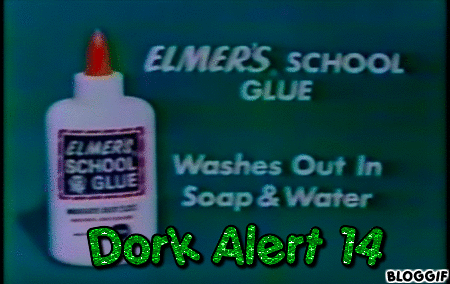
(the big list of favorite commercials archive)
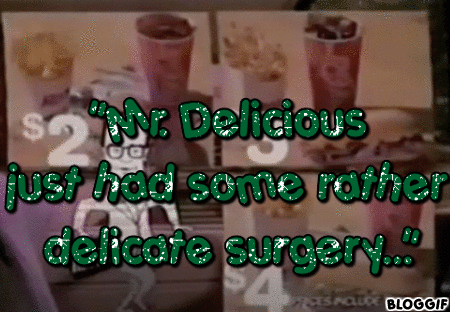
"Mr Delicious TV Ad 3 ( The one where he talks about his vasectomy)"
So, we all know the story about Mr. Delicious from Rax Roast Beef from the Vlog Brothers video and how the promotion was a total flop and Rax went into bankruptcy. I had to share him, though. This lil dude was way ahead of his time, I think if he had come out in about 1996 or 2003 people would've "gotten" him.
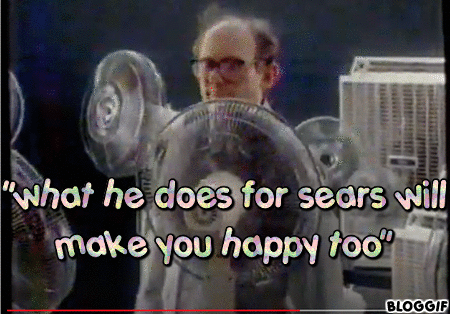
1987 Sears Retail Testing "Pete Menagin is a happy man" TV Commercial
First person in to be on the chopping block when Sears discontinued their catalog in 1993? Pete.
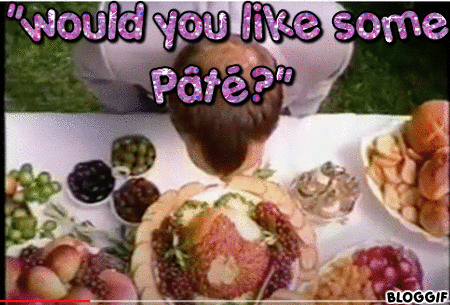
MERCK commercial featuring Scott Lowell (1999)
You ever wear the wrong thing, and you feel like everybody is looking at you? This commercial is that entire feel.
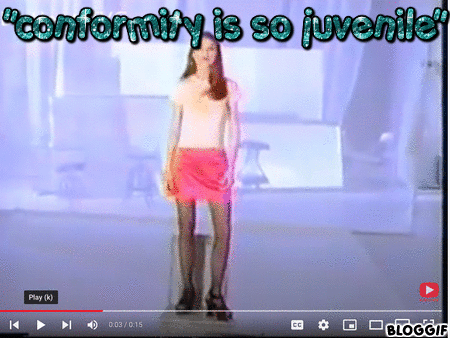
L'oreal Exuberance Werbung 1995
This outfit. THIS OUTFIT.
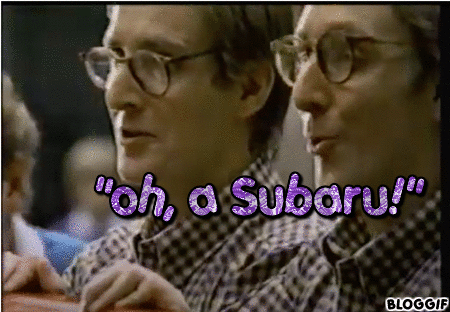
Subaru Justy commercial
Take your little tiny Justy and drive far way from your nosy ass family!

RC Cola & The 3 Bears Commercial | 1999 [Israel Subtitles Version 2]
This commercial is absolutely bonkers.
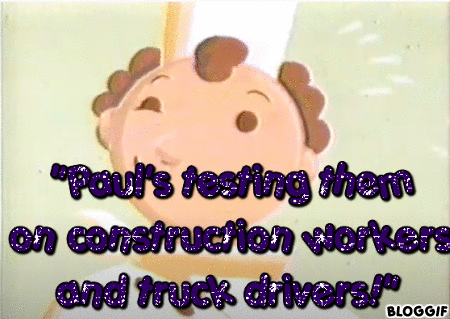
1998 Garden Burger "Paul is shining shoes" TV Commercial
What happened to Garden Burger?! They were white hot in the late 90s and then they disappeared. Loved their fake ribs. I think Kellogg's only offers them to food service companies like cafeterias?
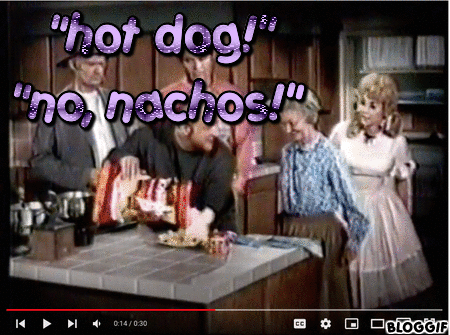
1998 Tostitos Nachos "Chris Elliot & The Beverly Hillbillies" TV Commercial
Remember when this was a trend? Putting dead celebrities in commercials and editing them to make them sell stuff? I gotta touch base more on that later. I also got to throw Chris Elliot a bone. I like his work on that one year he was on Saturday Night Live. That nacho topping looks gross tho.

Pillsbury Flour Funny 80s Commercial (1988)
Maybe because we don't bake or have never baked at my house, but a 25 pound bag of flour?!
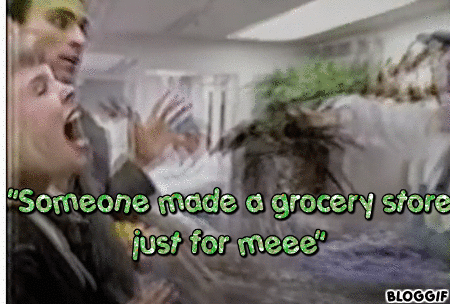
Food Emporium commercial (1988)
Okay, so #1 the lady in the commercial twirling around the store and being scared of a lobster looks exactly like the lady from the cover of that Yuppie Handbook. #2: Evian cameo. #3: someone in the comments said:
this is what you hear when you die and go to heaven
Facebook | Etsy | Retail History Blog | Twitter | YouTube Playlist | Random Post | Ko-fi donation | instagram @thelastvcr | tik tok @ saleintothe90s
8 notes
·
View notes
Photo
The most beautiful buildings do

Advertisements for Architecture 0175
558 notes
·
View notes
Text
Yesterday I have seen 'Beetlejuice' for the first time. 'Beetlejuice' ie a black comedy about the afterlife.
The central characters, Adam and Barbara Maitland, are a nice-but-wet young couple, who live just outside an idyllic small New England town in one of those huge, rambling weather boarded mansions that looks as though it has been taken straight from an Edward Hopper painting. After they are killed in a road accident, they return to their house as ghosts. The view of life after death in this film is an unusual one, which has little in common with Christian eschatology or with traditional ghost stories. The dead are compelled to return to the house where they lived during their lifetimes; if they attempt to go outside they find themselves in a desert landscape populated by monstrous worms. (This imagery was presumably derived from Frank Herbert's science-fiction novel 'Dune' and the film that was made from it a few years before 'Beetlejuice'). They can, however, contact other departed spirits who can help them cope with the trials of the afterlife by, for example, leaving them a copy of the 'Handbook for the Recently Deceased'.
The Maitlands' main trial takes the form of Charles and Delia Deetz, the pretentious yuppie couple who buy their house. Irritated beyond endurance by this tasteless pair, the Maitlands, attempt to scare them away, but their efforts prove ineffectual because the only member of the family who can see them is their daughter Lydia who, far from being frightened by Adam and Barbara, takes a liking to them and befriends them.
I was struck by the thematic similarity to Oscar Wilde's 'The Canterville Ghost', which deals with the attempts of a ghost to frighten away an American family living in his ancestral home. (In that story too the only person to befriend the ghost is the young daughter of the newcomers). Wilde's story, although it has moments of pathos, is also a satire directed against both the traditionalism and snobbery of the British aristocracy (represented by the ghost) and the materialism and brashness of the American nouveaux-riches. 'Beetlejuice' also contains some satirical material, chiefly at the expense of the pretentiously bohemian Deetz, who redecorate the Maitlands' house in a garish modernistic style and fill it with Delia's abstract sculptures. (It is never explained why a couple with such radically contemporary tastes would actually want to buy a Victorian mansion in the first place). Modern art, however, is a notoriously difficult subject to satirize, largely because it is impossible for the satirist to come up with a concept which is more extreme and exaggerated than the artists' own ideas. Delia's sculptures might look like pretentious tat, but one can see aesthetically similar items in established museums or in galleries bearing price-tags marked in thousands of pounds. Lydia, a follower of the then-fashionable 'Goth' cult, claims that she can see ghosts because she is 'strange and unusual'. The film loses the chance to make the point that the Goth movement, like most teenage cults from the Teddy Boys to grunge, was not so much strange and unusual.
Satire, however, is largely abandoned when the title character enters. Despairing of their own ability to scare away the intruders, the Maitlands engage the services of Betelgeuse, a 'bio-exorcist' who specializes in helping ghosts rid their properties of the unwanted living.
5 notes
·
View notes
Note
So... Morrison’s 10 part interview on All-Star Superman, along with all other older Newsarama articles, just seem to have ceased to exist. One does not simply live without having those interviews available to reread... Can I find them anywhere else?
Rejoice! I finally borrowed a computer I could put my flash drive into, and emailed myself my copy of the Morrison interview. Here it is below the cut, copied and pasted direct from the source way back when, available again at last:
Three years, 12 issues, Eisners and countless accolades later, All Star Superman is finally finished. The out-of-continuity look at Superman’s struggle with his inevitable death was widely embraced by fans and pros as one of the best stories to feature the Man of Steel, and was a showcase for the talents of the creative team of Grant Morrison, Frank Quitely and Jamie Grant.
Now, Newsarama is proud to present an exclusive look back with Morrison at the series that took Superman to, pun intended, new heights. We had a lot of questions about the series...and Morrison delivered with an in-depth look into the themes, characters and ideas throughout the 12 issues. In fact, there was so much that we’re running this as an unprecedented 10-part series over the next two weeks – sort of an unofficial All Star Superman companion. It’s everything about All Star Superman you ever wanted to know, but were afraid to ask.
And of course there’s plenty of SPOILERS, so back away if you haven’t read the entire series.
Newsarama: Grant, tell us a little about the origin of the project.
Grant Morrison: Some of it has its roots in the DC One Million project from 1999. So much so, that some readers have come to consider this a prequel to DC One Million, which is fine if it shifts a few more copies! I’ve tried to give my own DC books an overarching continuity intended to make them all read as a more coherent body of work when I’m done.
Luthor’s “enlightenment” – when he peaks on super–senses and sees the world as it appears through Superman’s eyes – was an element I’d included in the Superman Now pitch I prepared along with Mark Millar, Tom Peyer and Mark Waid back in 1999. There were one or two of ideas of mine that I wanted to preserve from Superman Now and Luthor’s heart–stopping moment of understanding was a favorite part of the original ending for that story, so I decided to use it again here.
My specific take on Superman’s physicality was inspired by the “shamanic” meeting my JLA editor Dan Raspler and I had in the wee hours of the morning outside the San Diego comic book convention in whenever it was, ‘98 or ‘99.
I’ve told this story in more detail elsewhere but basically, we were trying to figure out how to “reboot” Superman without splitting up his marriage to Lois, which seemed like a cop–out. It was the beginning of the conversations which ultimately led to Superman Now, with Dan and I restlessly pacing around trying to figure out a new way into the character of Superman and coming up short...
Until we looked up to see a guy dressed as Superman crossing the train tracks. Not just any skinny convention guy in an ill–fitting suit, this guy actually looked like Superman. It was too good a moment to let pass, so I ran over to him, told him what we’d been trying to do and asked if he wouldn’t mind indulging us by answering some questions about Superman, which he did...in the persona and voice of Superman!
We talked for an hour and a half and he walked off into the night with his friend (no, it wasn’t Jimmy Olsen, sadly). I sat up the rest of the night, scribbling page after page of Superman notes as the sun came up over the naval yards.
My entire approach to Superman had come from the way that guy had been sitting; so easy, so confident, as if, invulnerable to all physical harm, he could relax completely and be spontaneous and warm. That pose, sitting hunched on the bollard, with one knee up, the cape just hanging there, talking to us seemed to me to be the opposite of the clenched, muscle-bound look the character sometimes sports and that was the key to Superman for me.
I met the same Superman a couple of times afterwards but he wasn’t Superman, just a nice guy dressed as Superman, whose name I didn’t save but who has entered into my own personal mythology (a picture has from that time has survived showing me and Mark Waid posing alongside this guy and a couple of young readers dressed as Superboy and Supergirl – it’s in the “Gallery” section at my website for anybody who can be bothered looking. This is the guy who lit the fuse that led to All Star Superman).
After the 1999 pitch was rejected, I didn’t expect to be doing any further work on Superman but sometime in 2002, while I was going into my last year on New X–Men, Dan DiDio called and asked if I wanted to come back to DC to work on a Superman book with Jim Lee.
Jim was flexing his artistic muscles again to great effect, and he wanted to do 12 issues on Superman to complement the work he was doing with Jeph Loeb on “Batman: Hush.” At the time, I wasn’t able to make my own commitments dovetail with Jim’s availability, but by then I’d become obsessed with the idea of doing a big Superman story and I’d already started working out the details.
Jim, of course, went on to do his 12 Superman issues as “For Tomorrow” with Brian Azzarello, so I found myself looking for an artist for what was rapidly turning into my own Man of Steel magnum opus, and I already knew the book had to be drawn by my friend and collaborator, Frank Quitely.
We were already talking about We3 and Superman seemed like a good meaty project to get our teeth into when that was done. I completely scaled up my expectations of what might be possible once Frank was on board and decided to make this thing as ambitious as possible.
Usually, I prefer to write poppy, throwaway “live performance” type superhero books, but this time, I felt compelled to make something for the ages – a big definitive statement about superheroes and life and all that, not only drawn by my favorite artist but starring the first and greatest superhero of them all.
The fact that it could be a non–continuity recreation made the idea even more attractive and more achievable. I also felt ready for it, in a way I don’t think I would have been in 1999; I finally felt “grown–up” enough to do Superman justice.
I plotted the whole story in 2002 and drew tiny colored sketches for all 12 covers. The entire book was very tightly constructed before we started – except that I’d left the ending open for the inevitable better and more focused ideas I knew would arise as the project grew into its own shape...and I left an empty space for issue 10. That one was intended from the start to be the single issue of the 12–issue run that would condense and amplify the themes of all the others. #10 was set aside to be the one–off story that would sum up anything anyone needed to know about Superman in 22 pages.
Not quite as concise an origin as Superman’s, but that’s how we got started.
NRAMA: When you were devising the series, what challenges did you have in building up this version of the Superman universe?
GM: I couldn’t say there were any particular challenges. It was fun. Nobody was telling me what I could or couldn’t do with the characters. I didn’t have to worry about upsetting continuity or annoying people who care about stuff like that.
I don’t have a lot of old comics, so my knowledge of Superman was based on memory, some tattered “70s books from the remains of my teenage collection, a bunch of DC “Best Of...” reprint editions and two brilliant little handbooks – “Superman in Action Comics” Volumes 1 and 2 – which reprint every single Action Comics cover from 1938 to 1988.
I read various accounts of Superman’s creation and development as a brand. I read every Superman story and watched every Superman movie I could lay my hands on, from the Golden Age to the present day. From the Socialist scrapper Superman of the Depression years, through the Super–Cop of the 40s, the mythic Hyper–Dad of the 50s and 60s, the questioning, liberal Superman of the early 70s, the bland “superhero” of the late 70s, the confident yuppie of the 80s, the over–compensating Chippendale Superman of the 90s etc. I read takes on Superman by Mark Waid, Mark Millar, Geoff Johns, Denny O’Neil, Jeph Loeb, Alan Moore, Paul Dini and Alex Ross, Joe Casey, Steve Seagle, Garth Ennis, Jim Steranko and many others.
I looked at the Fleischer cartoons, the Chris Reeve movies and the animated series, and read Alvin Schwartz’s (he wrote the first ever Bizarro story among many others) fascinating book – “An Unlikely Prophet” – where he talks about his notion of Superman as a tulpa, (a Tibetan word for a living thought form which has an independent existence beyond its creator) and claims he actually met the Man of Steel in the back of a taxi.
I immersed myself in Superman and I tried to find in all of these very diverse approaches the essential “Superman–ness” that powered the engine. I then extracted, purified and refined that essence and drained it into All Star’s tank, recreating characters as my own dream versions, without the baggage of strict continuity.
In the end, I saw Superman not as a superhero or even a science fiction character, but as a story of Everyman. We’re all Superman in our own adventures. We have our own Fortresses of Solitude we retreat to, with our own special collections of valued stuff, our own super–pets, our own “Bottle Cities” that we feel guilty for neglecting. We have our own peers and rivals and bizarre emotional or moral tangles to deal with.
I felt I’d really grasped the concept when I saw him as Everyman, or rather as the dreamself of Everyman. That “S” is the radiant emblem of divinity we reveal when we rip off our stuffy shirts, our social masks, our neuroses, our constructed selves, and become who we truly are.
Batman is obviously much cooler, but that’s because he’s a very energetic and adolescent fantasy character: a handsome billionaire playboy in black leather with a butler at this beck and call, better cars and gadgetry than James Bond, a horde of fetish femme fatales baying around his heels and no boss. That guy’s Superman day and night.
Superman grew up baling hay on a farm. He goes to work, for a boss, in an office. He pines after a hard–working gal. Only when he tears off his shirt does that heroic, ideal inner self come to life. That’s actually a much more adult fantasy than the one Batman’s peddling but it also makes Superman a little harder to sell. He’s much more of a working class superhero, which is why we ended the whole book with the image of a laboring Superman.
He’s Everyman operating on a sci–fi Paul Bunyan scale. His worries and emotional problems are the same as ours... except that when he falls out with his girlfriend, the world trembles.
Newsarama: Grant, what are some of your favorite moments from the 12 issues?
Grant Morrison: The first shot of Superman flying over the sun. The Cosmic Anvil. Samson and Atlas. The kiss on the moon. The first three pages of the Olsen story which, I think, add up to the best character intro I’ve ever written.
Everything Lex Luthor says in issue #5. Everything Clark does. The whole says/does Luthor/Superman dynamic as played out through Frank Quitely’s absolute mastery and understanding of how space, movement and expression combine to tell a story.
Superboy and his dog on the moon – that perfect teenage moment of infinite possibility, introspection and hope for the future. He’s every young man on the verge of adulthood, Krypto is every dog with his boy (it seemed a shame to us that Krypto’s most memorable moment prior to this was his death scene in “Whatever Happened To The Man of Tomorrow.” Quitely’s scampering, leaping, eager and alive little creature is how I’d prefer to imagine Krypto the Superdog and conjures finer and more subtle emotions).
Bizarro–Home, with all of Earth’s continental and ocean shapes but reversed. The page with the first appearance of Zibarro that Frank has designed so the eye is pulled down in a swirling motion into the drain at the heart of the image, to make us feel that we’re being flushed in a cloacal spiral down into a nihilistic, existential sink. Frank gave me that page as a gift, and it became weirdly emblematic of a strange, dark time in both our lives.
The story with Bar–El and Lilo has a genuine chill off ammonia and antiseptic off it, which makes it my least favorite issue of the series, although I know a lot of people who love it. It’s about dying relatives, obligations, the overlit overheated corridors between terminal wards, the thin metallic odors of chemicals, bad food and fear. Preparation for the Phantom Zone.
Superman hugging the poor, hopeless girl on the roof and telling us all we’re stronger than we think we are.
Joe Shuster drawing us all into the story forever and never–ending.
Nasthalthia Luthor. Frank and Jamie’s final tour of the Fortress, referencing every previous issue on the way, in two pages.
All of issue #10 (there’s a single typo in there where the time on the last page was screwed up – but when we fix that detail for the trade I’ll be able to regard this as the most perfectly composed superhero story I’ve ever written).
I don’t think I’ve ever had a smoother, more seamless collaborative process.
NRAMA: The story is very complete unto itself, but are there any new or classic characters you’d like to explore further? If so, which ones and why?
GM: I’d happily write more Atlas and Samson. I really like Krull, the Dino–Czar’s wayward son, and his Stalinist underground empire of “Subterranosauri.” I could write a Superman Squad comic forever. I’d love to write the “Son of Superman” sequel about Lois and Clark’s super test tube baby.
But...I think All Star is already complete, without sequels. You read that last issue and it works because you know you��re never going to see All Star Superman again. You’ll be able to pick up Superman books, but they won’t be about this guy and they won’t feel the same. He really is going away. Our Superman is actually “dying” in that sense, and that adds the whole series a deeper poignancy.
NRAMA: Aside from the Bizarro League, you never really introduce other DC superheroes into the story. Why did you make this choice?
GM: I wanted the story to be about the mythic Superman at the end of his time. It’s clear from the references that he has or more likely has had a few super–powered allies, but that they’re no longer around or relevant any more.
For the context of this story I wanted the super–friends to be peripheral, like they were in the old comics. The Flash? Green Lantern? They represent Superman’s “old army buddies,” or your dad’s school friends. Guys you’ve sort of heard of, who used to be more important in the old man’s life than they are now.
NRAMA: Some readers were confused as to how the “Twelve Labors” broke down, though others have pointed out that Superman’s actions are more reflective of the Stations of the Cross (I note there’s a “Station Café” in the background of issue #12). Could you break down the Twelve Labors, or, if the cross theory is true, how the storyline reflects the Stations?
GM: The 12 Labors of Superman were never intended as an isomorphic mapping onto the 12 Labors of Hercules, or for that matter, the specific Stations of the Cross, of which there are 14, I believe. I didn’t even want to do one Labor per issue, so it deliberately breaks down quite erratically through the series for reasons I’ll go into (later).
Yes, there are correspondences, but that’s mostly because we tried to create for our Superman the contemporary “superhero” version of an archetypal solar hero journey, which naturally echoes numerous myths, legends and religious parables.
At the same time, we didn’t want to do an update or a direct copy of any myth you’d seen before, so it won’t work if you try to find one specific mythological or religious “plan” to hang the series on; James Joyce’s honorable and heroic refutation of the rule aside, there’s nothing more dead and dull than an attempt to retell the Odyssey or the Norse sagas scene by scene, but in a modern and/or superhero setting.
For future historians and mythologizers, however, the 12 Labors of Superman may be enumerated as follows:
1. Superman saves the first manned mission to the sun.
2. Superman brews the Super–Elixir.
3. Superman answers the Unanswerable Question.
4. Superman chains the Chronovore.
5. Superman saves Earth from Bizarro–Home.
6. Superman returns from the Underverse.
7. Superman creates Life.
8. Superman liberates Kandor/cures cancer.
9. Superman defeats Solaris.
10. Superman conquers Death.
11. Superman builds an artificial Heart for the Sun.
12.Superman leaves the recipe/formula to make Superman 2.
And one final feat, which typically no–one really notices, is that Lex Luthor delivers his own version of the unified field haiku – explaining the underlying principles of the universe in fourteen syllables – which the P.R.O.J.E.C.T. G–Type philosopher from issue 4 had dedicated his entire life to composing!
You may notice also that the Labors take place over a year – with the solar hero’s descent into the darkness and cold of the Underverse occurring at midwinter/Christmas time (that’s also the only point in the story where we ever see Metropolis at night).
It can also be seen as the sun’s journey over the course of a day – we open in blazing sunshine but halfway through the book, at the end of issue #5, in fact, the solar hero dips below the horizon and begins the night–journey through the hours of darkness and death, before his triumphant resurrection at dawn. That’s why issue 5 ends with the boat to the Underworld and 6 begins with the moon. Clark Kent is crossing the threshold into the subconscious world of memory, shadows, death and deep emotions.
Although they can often have bizarre resonances, specific elements, like the Station Café, are usually put there by Frank Quitely, and are not necessarily secret Dan Brown–style keys to unlocking the mysteries. I think there might be a Station Café opposite the studio where Frank Quitely works and the “SAPIEN” sign on another storefront is a reference to Frank’s studio mate, Dave Sapien. At least he’s not filling the background with dirty words like he used to, given any opportunity
NRAMA: For that matter, do the Twelve Labors matter at all? They seem so purposely ill–defined. They seem more like misdirection or a MacGuffin than anything that needs to be clearly delineated.
GM: They matter, of course, but the 12 Labors idea is there to show that, as with all myth, the systematic ordering of current events into stories, tales, or legends occurs after the fact.
I’m trying to suggest that only in the future will these particular 12 feats, out of all the others ever, be mythologized as 12 Labors. I suppose I was trying to say something about how people impose meaning upon events in retrospect, and that’s how myth is born. It’s hindsight that provides narrative, structure, meaning and significance to the simple unfolding of events. It’s the backward glance that adds all the capital letters to the list above.
Even Superman isn”t sure how many Labors he’s performed when we see him mulling it over in issue 10.
When you watched it happening, it seemed to be Superman just doing his thing. In the future it’s become THE 12 LABORS OF SUPERMAN!
NRAMA: And on a completely ridiculous note: All–Star Superman is perhaps the most difficult–to–abbreviate comic title since Preacher: Tall in the Saddle. Did you realize this going in?
GM: Going into what? Going into ASS itself? In the sense of how did I feel as I slowly entered ASS for the first time?
It never crossed my mind...
Newsarama: I’d like to know a little more about Leo Quintum and his role in the story. He seems like a bit of an outgrowth of the likes of Project Cadmus and Emil Hamilton, but in a more fantastical, Willy Wonka sense.
Grant Morrison: Yeah, he was exactly as you say, my attempt to create an updated take on the character of “Superman’s scientist friend” – in the vein of Emil Hamilton from the animated show and the ‘90s stories. Science so often goes wrong in Superman stories, and I thought it was important to show the potential for science to go right or to be elevated by contact with Superman’s shining positive spirit.
I was thinking of Quintum as a kind of “Man Who Fell To Earth” character with a mysterious unearthly background. For a while I toyed with the notion that he was some kind of avatar of Lightray of the New Gods, but as All Star developed, that didn’t fit the tone, and he was allowed to simply be himself.
Eventually it just came down to simplicity. Leo Quintum represents the “good” scientific spirit – the rational, enlightened, progressive, utopian kind of scientist I figured Superman might inspire to greatness. It was interesting to me how so many people expected Quintum to turn out bad at the end. It shows how conditioned we are in our miserable, self–loathing, suspicious society to expect the worst of everyone, rather than hope for the best. Or maybe it’s just what we expect from stories.
Having said that, there is indeed a necessary whiff of Lucifer about Quintum. His name, Leo Quintum, conjures images of solar force, lions and lightbringers and he has elements of the classic Trickster figure about him. He even refers to himself as “The Devil Himself” in issue #10.
What he’s doing at the end of the story should, for all its gee–whiz futurity, feel slightly ambiguous, slightly fake, slightly “Hollywood.” Yes, he’s fulfilling Superman’s wishes by cloning an heir to Superman and Lois and inaugurating a Superman dynasty that will last until the end of time – but he’s also commodifying Superman, figuring out how it’s done, turning him into a brand, a franchise, a bigger–and–better “revamp,” the ultimate coming attraction, fresher than fresh, newer than new but familiar too. Quintum has figured out the “formula” for Superman and improved upon it.
And then you can go back to the start of All Star Superman issue #1 and read the “formula” for yourself, condensed into eight words on the first page and then expanded upon throughout the story! The solar journey is an endless circle naturally. A perfect puzzle that is its own solution.
In one way, Quintum could be seen to represent the creative team, simultaneously re–empowering a pure myth with the honest fire of Art...while at the same time shooting a jolt of juice through a concept that sells more “S” logo underpants and towels than it does comic books. All tastes catered!
I have to say that the Willy Wonka thing never crossed my mind until I saw people online make the comparison, which seems quite obvious now. Quintum dresses how I would dress if I was the world’s coolest super–scientist. What’s up with that?
NRAMA: Was Zibarro inspired by the Bizarro World story where the Bizarro–Neanderthal becomes this unappreciated Casanova–type?
GM: Don’t know that one, but it sounds like a scenario I could definitely endorse!
Zibarro started out as a daft name sicked–up by my subconscious mind, which flowered within moments into the must–write idea of an Imperfect Bizarro. What would an imperfect version of an already imperfect being be like?
Zibarro.
NRAMA: I’d like to know more about Zibarro – what’s the significance of his chronicling Bizarro World through poetry?
GM: It’s up to you. I see Zibarro partly as the sensitive teenager inside us all. He’s moody, horribly self–aware and uncomfortable, yet filled with thoughts of omnipotence and agency. He’s the absolute center of his tiny, disorganized universe. He’s playing the role of sensitive, empathic poet but at the same time, he’s completely self–absorbed.
When he says to Superman “Can you even imagine what it’s like to be so different. So unique. So unlike everyone else?” he doesn’t even wait for Superman’s reply. He doesn’t care about anyone’s feelings but his own, ultimately.
NRAMA: The character is very close to Superman, so what does it say that a nonpowered version on a savage world would focus his energy through that medium? Also, does Zibarro’s existence show how Superman is able to elevate even the backwards Bizarros through his very nature?
GM: All of the above. And maybe he writes his totally subjective poetry as a reflection of Clark Kent’s objective reporter role. The suppressed, lyrical, wounded side of Superman perhaps? The Super–Morrissey? Bizarro With The Thorn In His Side?
But he’s also Bizarro–Home’s “mistake” (or so it seems to him, even though he’s as natural an expression of the place as any of the other Bizarro creatures who grow like mold across the surface of their living planet). He feels excluded, a despised outsider, and yet that position is what defines his cherished self–image. He expresses himself through poetry because to him the regular Bizarro language is barbaric, barely articulate and guttural. And they all think he’s talking crap anyway.
It seemed to make sense that an interesting opposite of Bizarro speech might be flowery “woe is me” school Poetry Society odes to the sunset in a misunderstood heart. He’s still a Bizarro though, which makes him ineffectual. His tragedy is that he knows he’s fated to be useless and pointless but craves so much more.
NRAMA: Zibarro also represents a recurrent theme in the story, of Superman constantly facing alternate versions of himself – Bar–El, Samson and Atlas, the Superman Squad, even Luthor by the end. Notably, Hercules is absent, though Superman’s doing his Twelve Labors. With the mythological adventurers in particular, was this designed to equate Superman with their legend, to show how his character is greater than theirs, or both?
GM: In a way, I suppose. He did arm–wrestle them both, proving once and for all Superman’s stronger than anybody! And remember, these characters, along with Hercules, used to appear regularly in Superman books as his rivals. I thought they made better rivals than, say, Majestic or Ultraman because people who don’t read comics have heard of Hercules, Samson and Atlas and understand what they represent.
For that particular story, I wanted to see Superman doing tough guy shit again, like he did in the early days and then again in the 70s, when he was written as a supremely cocky macho bastard for a while. I thought a little bit of that would be an antidote to the slightly soppy, Super–Christ portrayal that was starting to gain ground.
Hence Samson’s broken arm, twisted in two directions beyond all repair. And Atlas in the hospital. And then Superman’s got his hot girlfriend dressed like a girl from Krypton and they’re making out on the moon (the original panel description was of something more like the famous shot of Burt Lancaster and Deborah Kerr kissing in the surf from “From Here To Eternity.” Frank’s final choice of composition is much more classically pulp–romantic and iconic than my down and dirty rumble in the moondirt would have been, I’m glad to say).
Newsarama: Tell us about some of the thinking behind the new antagonists you created for this series (at least the ones you want to talk about...): First up: Krull and the Subterranosaurs...
Grant Morrison: We wanted to create some throwaway new characters which would be designed to look as if they were convincing long–term elements of the Superman legend.
We were trying to create a few foes who had a classic feel and a solid backstory that could be explored again or in depth. Even if we never went back to these characters, we wanted them to seem rich enough to carry their own stories.
With Krull, we figured a superhuman character like Superman can always use a powerful “sub–human” opponent: a beast, a monster, a savage with the power to destroy civilization. For years I’ve had the idea that the familiar “gray aliens” might “actually” be evolved biped dinosaur descendants, the offspring of smart–thinking lizards which made their way to the warm regions at the Earth’s core.
I imagined these brutes developing their own technology, their own civilization, and then finally coming to the surface to declare bloody war on the mammalian usurpers! It seemed like we could develop this idea into the Krull backstory and suggest a whole epic conflict in a few panels.
Dom Regan, the Glasgow artist and DC colorist, saw the original green skin Jamie Grant had done for Krull, and suggested we make him red instead. Jamie reset his color filters and that was the moment Krull suddenly looked like a real Superman foe.
The red skin marked him out as unique, different and dangerous, even among his own species. It had echoes of Jack Kirby’s Devil Dinosaur that played right into the heart of the concept. A good design became a great design and the whole story of who Krull was – his twisted relationship with his father the Dino–Czar, his monstrous ambitions – came together in that first picture.
The society was fleshed out in the script even though we see only one panel of it – a gloomy, heavy, “Soviet” underworld of walled iron cities, cold blood and deadly intrigue. War–Barges that could sail on the oceans of heated steam at the center of the Earth. A Stalinist authoritarian lizard world where missing person cases were being taken to work and die as slaves in hellish underworld conditions.
NRAMA: Mechano–Man?
GM: An attempt to pre–imagine a classic, archetypal Superman foe, which started with another simple premise – how about a giant robot villain? But not just any giant robot – this is a rampaging machine with a raging little man inside.
Giving him a bitter, angry, scrawny loser as a pilot turned Mechano–Man into a much more extreme and pathological expression of the Man of Steel/Mild–Mannered Reporter dynamic, and added a few interesting layers onto an 8–panel appearance.
NRAMA: The Chronovore – a very disturbing creation, that one.
GM: The Chronovore was mentioned in passing in DC 1,000,000 and would have been the monster in my aborted Hypercrisis series idea. It took a long time to get the right design for the beast because it’s meant to be a 5–D being that we only ever see in 4–D sections. It had to work as a convincing representation of something much bigger that we’re seeing only where it interpenetrates our 4–D space-time continuum.
Imagine you’re walking along with a song in your teenage heart, then suddenly the Chronovore appears, takes bite out of your life, and you arrive at your girlfriend’s house aged 76, clutching a cell phone and a wilted bouquet.
NRAMA: One more obscure run that I was happy to see referenced in this was the use of Nasty from the old Mike Sekowsky Supergirl stories. What made you want to use this character?
GM: I remembered her from the old comics, and felt her fashion–y look could be updated very easily into the kind of fetish club thing I’ve always been partial to.
She seemed a cool and sexy addition to the Luthor plot. The set–up, where Lex has a fairly normal sister who hates how her wayward brother is such a bad influence on her brilliant daughter, is explosive with character potential.
They need to bring Nasty back to mainstream continuity. Geoff! They all want it and you know you never let them down!
NRAMA: Speaking of Mike Sekowsky, I’m curious about his influence on your work. I have an odd fascination with all the ideas and stories he was tossing around in the late 1960s and early 1970s – Jason’s Quest, Manhunter 2070, the I–Ching tales – and many of the characters he worked on, from the B”Wana Beast to the Inferior Five to Yankee Doodle (in Doom Patrol), have shown up in your work. The Bizarro Zoo in issue #10 is even slightly reminiscent of the Beast’s merged animals.
GM: Those were all comics that were around when I was a normal kid, prior to the obsessive collecting fan phase of my isolated teenage years. They clearly inspired me in some way, as you say, but certainly not consciously. I’d never have considered myself a particular fan of Mike Sekowsky’s work, but as you say, I’ve incorporated a lot of his ideas into the DC Universe work I’ve done. Hmm. Interesting.
While I’m at it, I should also say something about Samson and Atlas, halfway between old characters and new.
Samson, Atlas and Hercules were classical mainstays of old Superman covers, tangling with Superman in all those Silver Age stories that happened before he learned from his friends at Marvel that it was possible to fight other superheroes for fun and profit, so I decided to completely “re–vamp” the characters in the manner of superhero franchises. Marvel has the definitive Hercules for me, so I left him out of the mix and concentrated on Atlas and Samson.
Atlas was re–imagined as a mighty but restless and reckless young prince of the New Mythos – a society of mega–beings playing out their archetypal dramas between New Elysium and Hadia, with ordinary people caught in the middle – and Superman.
Essentially good–hearted, Atlas would have been the newbie in a “team” with Skyfather Xaoz!, Heroina, Marzak and the others. He has a bullish, adolescent approach to life. He drinks and plunges himself into ill–advised adventures to ease his naturally gloomy “weighed down by the world” temperament.
You can see it all now. The backstory suggested an unseen, Empyrean New Gods–type series from a parallel universe. What if, when Jack Kirby came to DC from Marvel in 1971, he’d followed up his sci–fi Viking Gods saga at Marvel, with a dimension–spanning epic rooted in Greek mythology? New Gods meets Eternals drawn by Curt Swan/Murphy Anderson? That was Atlas.
Samson, I decided would be a callback to the British newspaper strip “Garth.” Although you may already be imagining a daily strip about the exploits of time–tossed The Boys writer, Garth Ennis, it was actually about a blonde Adonis type who bounced around the ages having mildly horny, racy adventures.
(Go look him up then return the wiser before reading on, so I don’t have to explain anymore about this bastard – he’s often described as “the British Superman,” but oh...my arse! I hated meathead, personality–singularity Garth...but we all grew up with his meandering, inexplicable yet incredibly–drawn adventures and some of it was quite good when you were a little lad because he was always shagging ON PANEL with the likes of a bare–breasted cave girl or gauze–draped Helen of Troy.
(Unlike Superman, you see, the top British strongman liked to get naked. Lots naked. Naked in every time period he could get naked in, which was all of them thanks to the miracle of his bullshit powers.
(Imagine Doctor Who buff, dumb and naked all the time – Russell, I’ve had an idea!!!! – and that’s Garth in a nutshell.
(Sorry, I know I’m going on and the average attention span of anyone reading stuff on the Internet amounts to no more than a few paragraphs, but basically, Garth was always getting naked. In public, in family newspapers. Bollock naked. Let’s face it, patriotic Americans, have you ever seen Superman’s arse?
Newsarama Note: Well, there was Baby Kal-El in the 1978 film...
(Brits, hands up who still remember the man, and have you ever not seen Garth’s arse? Do you not, in fact, have a very clear image of it in your head, as drawn by Martin Asbury perhaps? In mine, Garth’s pulling aside a flimsy curtain to gaze at the pyramids with Cleopatra buck naked in foreground ogling his rock hard glutes...).
Anyway, Samson, I decided, was the Hebrew version of Garth and he would have his own mad comic that was like an American version of Garth. I saw the Bible hero plucked from the desert sands by time–travelling buffoons in search of a savior. Introduced to all the worst aspects of future culture and, using his stolen, erratic Chrono–Mobile, Samson became a time–(and space) traveling Soldier of Fortune, writing wrongs, humping princesses, accumulating and losing treasure etc. Like a science fiction Conan. Meets Garth.
Fortunately, you’ll never see any of these men ever again.
Newsarama: How have your perceptions of Superman and his supporting characters evolved since the Superman 2000 pitch you did with Mark Waid, Mark Millar and Tom Peyer? The Superman notions seem almost identical, but Luthor is very different here than in that pitch, and so is Clark Kent. Did you use some aspects of your original pitch, or have you just changed his mind on how to portray these characters since?
Grant Morrison: A little of both. I wanted to approach All Star Superman as something new, but there were a couple of specific aspects from the Superman 2000 pitch (as I mentioned earlier, it was actually called Superman Now, at least in my notebooks, which is where the bulk of the material came from) that I felt were definitely worth keeping and exploring.
I can’t remember much about Luthor from Superman Now, except for the ending. By the time I got to All Star Superman, I’d developed a few new insights into Luthor’s character that seemed to flesh him out more. Luthor’s really human and charismatic and hateful all the same time. He’s the brilliant, deluded egotist in all of us. The key for me was the idea that he draws his eyebrows on. The weird vanity of that told me everything I needed to know about Luthor.
I thought the real key to him was the fact that, brilliant as he is, Luthor is nowhere near as brilliant as he wants to be or thinks he is. For Luthor, no praise, no success, no achievement is ever enough, because there’s a big hungry hole in his soul. His need for acknowledgement and validation is superhuman in scale. Superman needs no thanks; he does what he does because he’s made that way. Luthor constantly rails against his own sense of failure and inadequacy...and Superman’s to blame, of course.
I’ve recently been re–thinking Luthor again for a different project, and there’s always a new aspect of the character to unearth and develop.
NRAMA: This story makes Superman and Lois’ relationship seem much more romantic and epic than usual, but this one also makes Superman more of the pursuer. Lois seems like more of an equal, but also more wary of his affections, particularly in the black–and–white sequence in issue #2.
She becomes this great beacon of support for him over the course of the series, but there is a sense that she’s a bit jaded from years of trickery and uncomfortable with letting him in now that he’s being honest. How, overall, do you see the relationship between Superman and Lois?
GM: The black-and-white panels shows Lois paranoid and under the influence of an alien chemical, but yes, she’s articulating many of her very real concerns in that scene.
I wanted her to finally respond to all those years of being tricked and duped and led to believe Superman and Clark Kent were two different people. I wanted her to get her revenge by finally refusing to accept the truth.
It also exposed that brilliant central paradox in the Superman/Lois relationship. The perfect man who never tells a lie has to lie to the woman he loves to keep her safe. And he lives with that every day. It’s that little human kink that really drives their relationship.
NRAMA: Jimmy Olsen is extremely cool in this series – it’s the old “Mr. Action” idea taken to a new level. It’s often easy to write Jimmy as a victim or sycophant, but in this series, he comes off as someone worthy of being “Superman’s Pal” – he implicitly trusts Superman, and will take any risk to get his story. Do you see this version of Jimmy as sort of a natural evolution of the version often seen in the comics?
GM: It was a total rethink based on the aspects of Olsen I liked, and playing down the whole wet–behind–the–ears “cub reporter” thing. I borrowed a little from the “Mr. Action” idea of a more daredevil, pro–active Jimmy, added a little bit of Nathan Barley, some Abercrombie & Fitch style, a bit of Tintin, and a cool Quitely haircut.
Jimmy was renowned for his “disguises” and bizarre transformations (my favorite is the transvestite Olsen epic “Miss Jimmy Olsen” from Jimmy Olsen #95, which gets a nod on the first page of our Jimmy story we did), so I wanted to take that aspect of his appeal and make it part of his job.
I don’t like victim Jimmy or dumb Jimmy, because those takes on the character don’t make any sense in their context. It seemed more interesting see what a young man would be like who could convincingly be Superman’s “pal.” Someone whose company a Superman might actually enjoy. That meant making Jimmy a much bigger character: swaggering but ingenuous. Innocent yet worldly. Enthusiastic but not stupid.
My favorite Jimmy moment is in issue #7 when he comes up with the way to defeat the Bizarro invasion by using the seas of the Bizarro planet itself as giant mirrors to reflect toxic – to Bizarros – sunlight onto the night side of the Earth. He knows Superman can actually take crazy lateral thinking like this and put it into practice.
NRAMA: Perry White has a few small–but–key scenes, particularly his address to his staff in issue #1 and standing up to Luthor in issue #12. I’d like to hear more about your thoughts on this character.
GM: As with the others, my feelings are there on the page. Perry is Clark’s boss and need only be that and not much more to play his role perfectly well within the stories. He’s a good reminder that Superman has a job and a boss, unlike that good–for–nothing work-shy bastard Batman. Perry’s another of the series’ older male role models of integrity and steadfastness, like Pa Kent.
NRAMA: There’s a sense in the Daily Planet scenes and with Lois’s spotlight issues that everyone knows Clark is Superman, but they play along to humor him. The Clark disguise comes off as very obvious in this story. Do you feel that the Planet staff knows the truth, or are just in a very deep case of denial, like Lex?
GM: If I had to say for sure, I think Jimmy Olsen worked it out a long time ago, and simply presumes that if Superman has a good reason for what he’s doing, that’s good enough for Jimmy.
Lois has guessed, but refuses to acknowledge it because it exposes her darkest flaw – she could never love Clark Kent the way she loves Superman.
NRAMA: Also, the Planet staff seems awfully nonchalant at Luthor’s threats. Are they simply used to being attacked by now?
GM: Yes. They’re a tough group. They also know that Superman makes a point of looking out for them, so they naturally try to keep Luthor talking. They know he loves to talk about himself and about Superman. In that scene, he’s almost forgotten he even has powers, he’s so busy arguing and making points. He keeps doing ordinary things instead of extraordinary things.
NRAMA: The running gag of Clark subtly using his powers to protect unknowing people is well done, but I have to admit I was confused by the sequence near the end of issue #1. Was that an el–train, and if so, why was it so close to the ground?
GM: It’s a MagLev hover–train. Look again, and you’ll see it’s not supported by anything. Hover–trains help ease congestion in busy city streets! Metropolis is the City of Tomorrow, after all.
NRAMA: And there’s the death of Pa Kent. Why do you feel it’s particularly important to have Pa and not both of the Kents pass away?
GM: I imagined they had both passed away fairly early in Superman’s career, but Ma went a few years after Pa. Also, because the book was about men or man, it seemed important to stress the father/son relationships. That circle of life, the king is dead, long live the king thing that Superman is ultimately too big and too timeless to succumb to.
NRAMA: There is a real touch of Elliott S! Maggin’s novels in your depiction of Luthor – someone who is just so obsessive–compulsive about showing up Superman that he accomplishes nothing in his own life. He comes across as a showman, from his rehearsed speech in issue #1 to his garish costume in the last two issues, and it becomes painfully apparent that he wants to usurp Superman because he just can’t be happy with himself. What defeats him is actually a beautiful gift, getting to see the world as Superman does, and finally understanding his enemy.
That’s all a lead–in to: What previous stories that defined Luthor for you, and how did you define his character? What appeals to you about writing him?
GM: The Marks Waid and Millar were big fans of the Maggin books, and may have persuaded me to read at least the first one but I’m ashamed to say can’t remember anything about it, other than the vague recollection of a very humane, humanist take on Superman that seemed in general accord with the pacifist, hedonistic, between–the–wars spirit of the ‘90s when I read it. It was the ‘90s; I had other things on my mind and in my mind.
I like Maggin’s “Must There Be A Superman?” from Superman #247, which ultimately poses questions traditional superhero comic books are not equipped to answer and is one of the first paving stones in the Yellow Brick Road that leads to Watchmen and beyond, to The Authority, The Ultimates etc. Everyone still awake, still reading this, should make themselves familiar with “Must There Be A Superman?” – it’s a milestone in the development of the superhero concept.
However, the story that most defines Luthor for me turns out to be, as usual, a Len Wein piece with Curt Swan/Murphy Anderson– Superman #248. This blew me away when I was a kid. Lex Luthor cares about humanity? He’s sorry we all got blown up? The villain loves us too? It’s only Superman he really hates? Genius. Big, cool adult stuff.
The divine Len makes Lex almost too human, but it was amazing to see this kind of depth in a character I’d taken for granted as a music hall villain.
I also love the brutish Satanic, Crowley–esque, Golden Age Luthor in the brilliant “Powerstone” Action Comics #47 (the opening of All Star #11 is a shameless lift from “Powerstone”, as I soon realised when I went back to look. Blame my...er...photographic memory...cough).
And I like the Silver Age Luthor who only hates Superman because he thinks it’s Superboy’s fault he went bald. That was the most genuinely human motivation for Luthor’s career of villainy of all; it was Superman’s fault he went bald! I can get behind that.
In the Silver Age, baldness, like obesity, old age and poverty, was seen quite rightly as a crippling disease and a challenge which Superman and his supporting cast would be compelled to overcome at every opportunity! Suburban “50s America versus Communist degeneracy? You tell me.
I like elements of the Marv Wolfman/John Byrne ultra–cruel and rapacious businessman, although he somewhat lacks the human dimension (ultimately there’s something brilliant about Luthor being a failed inventor, a product of Smallville/Dullsville – the genius who went unnoticed in his lifetime, and resorted to death robots in chilly basements and cellars. Luthor as geek versus world). I thought Alan Moore’s ruthlessly self–assured “consultant” Luthor in Swamp Thing was an inspired take on the character as was Mark Waid’s rage–driven prodigy from Birthright.
I tried to fold them all into one portrayal. I see him as a very human character – Superman is us at our best, Luthor is us when we’re being mean, vindictive, petty, deluded and angry. Among other things. It’s like a bipolar manic/depressive personality – with optimistic, loving Superman smiling at one end of the scale and paranoid, petty Luthor cringing on the other.
I think any writer of Superman has to love these two enemies equally. We have to recognize them both as potentials within ourselves. I think it’s important to find yourself agreeing with Luthor a bit about Superman’s “smug superiority” – we all of us, except for Superman, know what it’s like to have mean–spirited thoughts like that about someone else’s happiness. It’s essential to find yourself rooting for Lex, at least a little bit, when he goes up against a man–god armed only with his bloody–minded arrogance and cleverness.
Even if you just wish you could just give him a hug and help him channel his energies in the right direction, Luthor speaks for something in all of us, I like to think.
However he’s played, Luthor is the male power fantasy gone wrong and turned sour. You’ve got everything you want but it’s not enough because someone has more, someone is better, someone is cleverer or more handsome.
Newsarama: Grant, a recurring theme throughout the book is the effect of small kindness – how even the likes of Steve Lombard are capable of decency. And Superman gets the key to saving himself by doing something that any human being could do, offering sympathy to a person about to end it all.
Grant Morrison: Completely...the person you help today could be the person who saves your life tomorrow.
NRAMA: The character actions that make the biggest difference, from Zibarro’s sacrifice to Pa’s influence on Superman, are really things that any normal, non-powered person could do if they embrace the best part of their humanity. The last page of issue #12 teases the idea that Superman’s powers could be given to all mankind, but it seems as though the greatest gift he has given them is his humanity. How do you view Superman’s fate in the context of where humanity could go as a species?
GM: I see Superman in this series as an Enlightenment figure, a Renaissance idea of the ideal man, perfect in mind, body and intention.
A key text in all of this is Pico’s ‘Oration On The Dignity of Man’ (15c), generally regarded as the ‘manifesto’ of Renaissance thought, in which Giovanni Pico Della Mirandola laid out the fundamentals of what we tend to refer to as ’Humanist’ thinking.
(The ‘Oratorio’ also turns up in my British superhero series Zenith from 1987, which may indicate how long I’ve been working towards a Pico/Superman team-up!)
At its most basic, the ‘Oratorio’ is telling us that human beings have the unique ability, even the responsibility, to live up to their ‘ideals’. It would be unusual for a dog to aspire to be a horse, a bird to bark like a dog, or a horse to want to wear a diving suit and explore the Barrier Reef, but people have a particular gift for and inclination towards imitation, mimicry and self-transformation. We fly by watching birds and then making metal carriers that can outdo birds, we travel underwater by imitating fish, we constantly look to role models and behavioral templates for guidance, even when those role models are fictional TV or, comic, novel or movie heroes, just like the soft, quick, shapeshifty little things we are. We can alter the clothes we wear, the temperature around us, and change even our own bodies, in order to colonize or occupy previously hostile environments. We are, in short, a distinctively malleable and adaptable bunch.
So, Pico is saying, if we live by imitation, does it not make sense that we might choose to imitate the angels, the gods, the very highest form of being that we can imagine? Instead of indulging the most brutish, vicious, greedy and ignorant aspects of the human experience, we can, with a little applied effort, elevate the better part of our natures and work to express those elements through our behavior. To do so would probably make us all feel a whole lot better too. Doing good deeds and making other people happy makes you feel totally brilliant, let’s face it.
So we can choose to the astronaut or the gangster. The superhero or the super villain. The angel or the devil. It’s entirely up to us, particularly in the privileged West, how we choose to imagine ourselves and conduct our lives.
We live in the stories we tell ourselves. It’s really simple. We can continue to tell ourselves and our children that the species we belong to is a crawling, diseased, viral cancer smear, only fit for extinction, and let’s see where that leads us.
We can continue to project our self-loathing and narcissistic terror of personal mortality onto our culture, our civilization, our planet, until we wreck the promise of the world for future generations in a fit of sheer self-induced panic...
...or we can own up to the scientific fact that we are all physically connected as parts of a single giant organism, imagine better ways to live and grow...and then put them into practice. We can stop pissing about, start building starships, and get on with the business of being adults.
The ’Oratorio’ is nothing less than the Shazam!, the Kimota! for Western Culture and we would do well to remember it in our currently trying times.
The key theme of the ‘Dark Age’ of comics was loss and recovery of wonder - McGregor’s Killraven trawling through the apocalyptic wreckage of culture in his search for poetry, meaning and fellowship, Captain Mantra, amnesiac in Robert Mayer’s Superfolks, Alan Moore’s Mike Maxwell trudging through the black and white streets of Thatcher’s Britain, with the magic word of transformation burning on the tip of his tongue.
My own work has been an ongoing attempt to repeat the magic word over and over until we all become the kind of superheroes we’d all like to be. Ha hah ha.
Newsarama: The structure of the 12 issues involves both Superman’s 12 labors and his impending death. Do you feel the threat of his demise brings out the best in Superman’s already–high character, or did you intend it more as a window for the audience to understand how he sees the world?
Grant Morrison: In trying to do the “big,” ultimate Superman story, we wanted to hit on all the major beats that define the character – the “death of Superman” story has been told again and again and had to be incorporated into any definitive take. Superman’s death and rebirth fit the sun god myth we were establishing, and, as you say, it added a very terminal ticking clock to the story.
NRAMA: When we talked earlier this year, we discussed the neurotic quality of the Silver Age stories. Looking at the series as a whole, you consistently invert this formula. Superman is faced with all these crises that could be seen as personifying his neuroses, but for the most part he handles them with a level head and comes across as being very at peace with himself. You talked about your discussion with an in–character Superman fan at a convention years ago, but I am curious as to how you determined Superman’s mindset.
GM: I felt we had to live up to the big ideas behind Superman. I don’t take my daft job lightly. It’s all I’ve got.
As the project got going, I wasn’t thinking about Silver Ages or Dark Ages or anything about the comics I’d read, so much as the big shared idea of “Superman” and that “S” logo I see on T–shirts everywhere I go, on girls and boys. That communal Superman. I wanted us to get the precise energy of Platonic Superman down on the page.
The “S” hieroglyph, the super–sigil, stands for the very best kind of man we can imagine, so the subject dictated the methodical, perfectionist approach. As I’ve mentioned before, I keep this aspect of my job fresh for myself by changing my writing style to suit the project, the character or the artist.
With something like Batman R.I.P., I’m aiming for a frenzied Goth Pulp-Noir; punk-psych, expressionist shadows and jagged nightmare scene shifts, inspired by Batman’s roots and by the snapping, fluttering of his uncanny cape. Final Crisis was written, with the Norse Ragnarok and Biblical Revelations in mind, as a story about events more than characters. A doom-laden, Death Metal myth for the wonderful world of Fina(ncia)l Crisis/Eco-breakdown/Terror Trauma we all have to live in.
The subject matter drives the execution. And then, of course, the artists add their own vision and nuance. With All Star Superman, “Frank” and I were able to spend a lot of time together talking it through, and we agreed it had to be about grids, structure, storybook panel layouts, an elegance of form, a clarity of delivery. “Classical” in every sense of the word. The medium, the message, the story, the character, all working together as one simple equation.
Frank Quitely, a Glasgow Art School boy, completely understood without much explanation, the deep structural underpinnings of the series and how to embody them in his layouts. There’s a scene in issue # 8, set on the Bizarro world, where we see Le Roj handing Superman his rocket plans. Look at the arrangement of the figures of Zibarro, Le Roj, Superman and Bizaro–Superman and you’ll see one attempt to make us of Renaissance compositions.
The sense of sunlit Zen calm we tried to get into All Star is how I imagine it might feel to think the way Superman thinks all the time - a thought process that is direct, clean, precise, mathematical, ordered. A mind capable of fantastical imagination but grounded in the everyday of his farm upbringing with nice decent folks. Rich with humour and tears and deep human significance, yet tuned to a higher key. We tried to hum along for a little while, that’s all.
In honor of the character’s primal position in the development of the superhero narrative, I hoped we could create an “ultimate” hero story, starring the ultimate superhero.
Basically, I suppose I felt Superman deserved the utmost application of our craft and intelligence in order to truly do him justice.
Otherwise, I couldn’t have written this book if I hadn’t watched my big, brilliant dad decline into incoherence and death. I couldn’t have written it if I’d never had my heart broken, or mended. I couldn’t have written it if I hadn’t known what it felt like to be idolized, misunderstood, hated for no clear reason, loved for all my faults, forgotten, remembered...
Writing All Star Superman was, in retrospect, also a way of keeping my mind in the clean sunshine while plumbing the murkiest depths of the imagination with that old pair of c****s Darkseid and Doctor Hurt. Good riddance.
Newsarama: This is touched on in other questions, but how much of the Silver/Bronze Age backstory matters here? What do you see as Superman's life prior to All-Star Superman? (What was going on with this Superman while the Byrne revamp took hold?)
Grant Morrison: When I introduced the series in an interview online, I suggested that All Star Superman could be read as the adventures of the ‘original’ Pre-Crisis on Infinite Earths Superman, returning after 20 plus years of adventures we never got to see because we were watching John Byrne‘s New Superman on the other channel. If ‘Whatever Happened To The Man of Tomorrow?’ and the Byrne reboot had never happened, where would that guy be now?
This was more to provide a sense, probably limited and ill-considered, of what the tone of the book might be like. I never intended All Star Superman as a direct continuation of the Weisinger or Julius Schwartz-era Superman stories. The idea was always to create another new version of Superman using all my favorite elements of past stories, not something ‘Age’ specific.
I didn’t collect Superman comics until the ‘70s and I’m not interested enough in pastiche or nostalgia to spend 6 years of my life playing post-modern games with Superman. All Star isn’t written, drawn or colored to look or read like a Silver Age comic book.
All Star Superman is not intended as arch commentary on continuity or how trends in storytelling have changed over the decades. It’s not retro or meta or anything other than its own simple self; a piece of drawing and writing that is intended by its makers to capture the spirit of its subject to the best of their capabilities, wisdom and talent.
Which is to say, we wanted our Superman story be about life, not about comics or superheroes, current events or politics. It’s about how it feels, specifically to be a man...in our dreams! Hopefully that means our 12 issues are also capable of wide interpretation.
So as much as we may have used a few recognizable Silver Age elements like Van-Zee and Sylv(i)a and the Bottle City of Kandor, the ensemble Daily Planet cast embodies all the generations of Superman. Perry White is from 1940, Steve Lombard is from the Schwartz-era ‘70s, Ron Troupe - the only black man in Metropolis - appeared in 1991. Cat Grant is from 1987 and so on.
P.R.O.J.E.C.T. refers back to Jack Kirby’s DNA Project from his ‘70s Jimmy Olsen stories, as well as to The Cadmus Project from ’90s Superboy and Superman stories. Doomsday is ‘90s. Kal Kent, Solaris and the Infant Universe of Qwewq all come from my own work on Superman in the same decade. Pa Kent’s heart attack is from ‘Superman the Movie‘. We didn’t use Brainiac because he’d been the big bad in Earth 2 but if we had, we’d have used Brainiac’s Kryptonian origin from the animated series and so on.
I also used quite a few elements of John Byrne’s approach. Byrne made a lot of good decisions when he rebooted the whole franchise in 1986 and I wanted to incorporate as much as I could of those too.
Our Superman in All Star was never Superboy, for instance. All Star Superman landed on Earth as a normal, if slightly stronger and fitter infant, and only began to manifest powers in adolescence when he’d finally soaked up enough yellow solar radiation to trigger his metamorphosis.
The Byrne logic seemed to me a better way to explain how his powers had developed across the decades, from the skyscraper leaps of the early days to the speed-of-light space flight of the high Silver Age. And more importantly, it made the Superman myth more poignant - the story of a farm boy who turned into an alien as he reached adolescence. I felt that was something that really enriched Superman. He grew away from his home, his family, his adopted species as he became Superman. His teenage years are a record of his transformation from normal boy to super-being.
As you say, there are more than just Silver Age influences in the book. Basically we tried to create a perfect synthesis of every Superman era. So much so, that it should just be taken as representative of an ‘age’ all its own.
In the end, however, I do think that the Silver Age type stories, with their focus on human problems and foibles, have a much wider appeal than a lot of the work which followed. They’re more like fables or folk tales than the later ‘comic book superhero’ stories of Superman when he became just another colorful costume in the crowd...and perhaps that’s why All Star seemed to resemble those books more than it does a typical modern Marvel or DC comic. It was our intention to present a more universal, mainstream Superman.
NRAMA: In your depiction of Krypton and the Kryptonians, you show the complexity of Superman’s relationship between humanity and Earth even further. Krypton has that scientific paradise quality to it, but the Kryptonians are also portrayed as slightly aloof and detached, even Jor-El. But from Bar-El to the people of Kandor, they’re touched by Superman’s goodness. What do you see as the fundamental difference between Kryptonians and Earthlings, and how has Superman’s character been shaped by each?
GM: My version of Krypton was, again, synthesized from a number of different approaches over the decades.
In mythic terms, if Superman is the story of a young king, found and raised by common people, then Krypton is the far distant kingdom he lost. It’s the secret bloodline, the aristocratic heritage that makes him special, and a hero. At the same time, Krypton is something that must be left behind for Superman to become who he is - i.e. one of us. Krypton gives him his scientific clarity of mind, Earth makes his heart blaze.
I liked the very early Jerry Siegel descriptions where Krypton is a planet of advanced supermen and women (I already played with that a little in Marvel Boy where Noh-Varr was written to be the Marvel Superboy basically). To that, I added the rich, science fiction detailing of the Silver Age Krypton stories and the slightly detached coolness that characterized John Byrne’s Krypton, which I re-interpreted through the lens of Dzogchen Buddhist thought, probably the most pragmatic, chilly and rational philosophic system on the planet and the closest, I felt, to how Kryptonians might see things.
We also took some time to redesign the crazy, multicolored Kryptonian flag (you can see our version in Kandor in issue #10). The flag, as originally imagined, seemed like the last thing Kryptonians would endorse, so we took the multicolored-rays-around-a-circle design and recreated it - the central circle is now red, representing Krypton’s star, Rao, while the rays, rather than arbitrary colors, become representations of the spectrum of visible light pouring from Rao into the inky black of space. In this way, the flag, that bizarre emblem of nationalism becomes a scientific hieroglyph.
Showing Krypton and Kryptonians was also important as a way of stressing why Superman wears that costume and why it makes absolute sense that he looks the way he does. I don’t see the red and blue suit as a flag or as rewoven baby blankets. There’s no need for Superman to dress the way he does but it made sense to think of his outfit as his ‘national costume‘.
The way I see it, the standard superhero outfit, the familiar Superman suit with the pants on the outside, is what everyone wore on Krypton, give or take a few fashion accessories like hoods and headbands, chest crests and variant colors. In fact, all other superheroes are just copying the fashions on Krypton, lost planet of the super-people.
Superman wears his ’action-suit’ the way a patriotic Scotsman would wear a kilt. It’s a sign of his pride in his alien heritage.
Newsarama: Although All–Star Superman ties in with DC One Million, you style of writing has changed dramatically since then. How do you feel about One Million now?
Grant Morrison: I just read it again and liked it a lot. Comics were definitely happier, breezier and more confident in their own strengths before Hollywood and the Internet turned the business of writing superhero stories into the production of low budget storyboards or, worse, into conformist, fruitless attempts to impress or entertain a small group of people who appear to hate comics and their creators.
NRAMA: Obviously, this book is the most explicit SF–Christ story since Behold the Man, only...happy. Superman/Christ parallels have existed for decades, but this story makes it absolutely explicit, from laying his hands on the sick and dying to...well, most of issue #12. You’ve dealt with Christ themes before, particularly in The Mystery Play, but outside of the comics, how do you see Superman as a Christ figure for the “real” world?
GM: The “Superman as Christ” thing is a little too reductive for me, and tends to overlook the fact that Superman is by no means a pacifist in the Christ sense. Superman would never turn the other cheek; Superman punches out the bully. Superman is a fighter.
When did Christ ever batter the Devil through a mountain?
The thing I disliked about the Superman Returns movie was the American Christ angle, which reduced Superman to a sniveling, masochistic wreck, crawling around on the floor, taking a kicking from everyone. This approach had an odd and slightly disturbing S&M flavor, which didn’t play well to the character’s strengths at all and seemed to derive entirely from a kind of Catholic vision of the suffering, martyred Jesus.
It’s not that he’s based on Jesus, but simply that a lot of the mythical sun god elements that have been layered onto the Christ story also appear in the story of Superman. I suppose I see Superman more as pagan sci–fi. He’s a secular messiah, a science redeemer with tough guy muscles and a very direct and clear morality.
NRAMA: Continuing the religious themes, in issue #10, you have Superman literally giving birth to himself, both philosophically and as a character – a nice little meta–moment showing how Superman inspires a world where he is only fiction. How did that idea come about?
GM: It came from the challenge we’d set ourselves: as I said, issue #10 had been left as a blank space into which the single most coherent condensation of all our ideas about Superman were destined to fit.
I wanted to do a “day in the life” story. So much of All Star had been about this threat to Superman himself, so we wanted to show him going about a typical day saving people and doing good.
Then came the title “Neverending,” which comes from the opening announcement – “Faster than a speeding bullet!...” of the Superman radio show from 1940, and seemed to me to be as good a title for a Superman story as any I could think of. It seemed to distil everything about Superman’s battle and his legend into a single word. And the story structure itself was designed to loop endlessly, so it went well with that.
On top of that went the idea of the Last Will and Testament of Superman. A dying god writing his will seemed like an interesting structure to use. Then came the idea to fit all of human history into that single 24 hours. And then to show the development of the Superman idea through human culture from the earliest Australian Aboriginal notions of super–beings ‘descended” from the sky, through the complex philosophical system of Hinduism, onto the Renaissance concept of the ideal man, via the refinements of Nietzche and finally, down to that smiling, hopeful Joe Shuster sketch; the final embodiment of humanity’s glorious, uplifting notion of the superman become reduced to a drawing, a story for kids, a worthless comic book.
And also what that could mean in a holographic fractal universe, where the smallest part contains and reflects the whole.
Of course the next panel in that sequence is happening in the real world and would show you, the reader, sitting with the latest Superman issue in your hands, deep within the Infant Universe of Qwewq in the Fortress of Solitude, today, wherever you are. In “Neverending,” the reader becomes wrapped in a self–referential loop of story and reality. If you actually, seriously think about what is happening at this point in the story, if you meditate upon the curious entanglement of the real and the fictional, you will become enlightened in this life apparently. According to some texts.
NRAMA: On a personal level, you’ve explored all types of religions and philosophies in your work. What is your take on religion and how it influences humanity, and the Christian take on Jesus Christ in particular?
GM: I think religion per se, is a ghastly blight on the progress of the human species towards the stars. At the same time, it, or something like it, has been an undeniable source of comfort, meaning and hope for the majority of poor bastards who have ever lived on Earth, so I’m not trying to write it off completely. I just wish that more people were educated to a standard where they could understand what religion is and how it works. Yes, it got us through the night for a while, but ultimately, it’s one of those ugly, stupid arse–over–backwards things we could probably do without now, here on the Planet of the Apes.
Religion is to spirituality what porn is to sex. It’s what the Hollywood 3–act story template is to real creative writing.
Religion creates a structure which places “special,” privileged people (priests) between ordinary people and the divine, as if there could even be any separation: as if every moment, every thought, every action was not already an expression of dynamic ‘divinity” at work.
As I’ve said before, the solid world is just the part of heaven we’re privileged to touch and play with. You don’t need a priest or a holy man to talk to “god” on your behalf: just close your eyes and say hello. “God” is no more, no less, than the sum total of all matter, all energy, all consciousness, as experienced or conceptualized from a timeless perspective where everything ever seems to present all at once. “God” is in everything, all the time and can be found there by looking carefully. The entire universe, including the scary, evil bits, is a thought “God” is thinking, right now.
As far as I can figure it out from my own reading and my own experience of how the spiritual world works, Jesus was, as they say, way cool: a man who achieved a state of consciousness, which nowadays would get him a diagnosis of temporal lobe epilepsy (in the days of the Emperor Tiberius, he was crucified for his ideas, today he’d be laughed at, mocked or medicated).
This “holistic” mode of consciousness (which Luthor experiences briefly at the end of All Star Superman) announces itself as a heartbreaking connection, a oneness, with everything that exists...but you don’t have to be Superman to know what that feeling is like. There are a ton of meditation techniques which can take you to this place. I don’t see it as anything supernatural or religious, in fact, I think it’s nothing more than a developmental level of human consciousness, like the ability to see perspective – which children of 4 cannot do but children of 6 can.
Everyone who’s familiar with this upgrade will tell you the same thing: it feels as if “alien” or “angelic” voices – far more intelligent, coherent and kindly than the voices you normally hear in your head – are explaining the structure of time and space and your place in it.
This identification with a timeless supermind containing and resolving within itself all possible thoughts and contradictions, is what many people, unsurprisingly, mistake for an encounter with “God.” However, given that this totality must logically include and resolve all possible thoughts and concepts, it can also be interpreted as an actual encounter with God, so I’m not here to give anyone a hard time over interpretation.
Some people have the experience and believe the God of their particular culture has chosen them personally to have a chat with. These people may become born–again Christians, fundamentalist Muslims, devotees of Shiva, or misunderstood lunatics. Some “contactees” interpret the voices they hear erroneously as communications from an otherworldly, alien intelligence, hence the proliferation of “abduction” accounts in recent decades, which share most of their basic details with similar accounts, from earlier centuries, of people being taken away by “fairies” or “little people”.
Some, who like to describe themselves as magicians, will recognize the “alien” voice as the “Holy Guardian Angel”.
In timeless, spaceless consciousness, the singular human mind blurs into a direct experience of the totality of all consciousness that has ever been or will ever be. It feels like talking with God but I see that as an aspect of science, not religion.
As Peter Barnes wrote in “The Ruling Class”, “I know I must be God because when I pray to Him, I find I’m talking to myself.”
Newsarama: When we spoke earlier this year, you talked about some of your ideas for future All Star stories. Are you moving forward on those, or have you started working on different ideas since then?
Grant Morrison: I haven’t had time to think about them for a while. I did have the stories worked out, and I’d like to do more, but right now it feels like Frank and Jamie and I have said all there is to be said. I don’t know if I’m ready to do All Star Superman with anyone else right now. I have other plans.
NRAMA: You end the book with Superman having uplifted humanity – having inspired them through his sacrifice and great deeds, and with the potential to pass his powers on to humanity still there. Do you plan to explore this concept further, or would you prefer to leave it open–ended?
GM: I may go back to the Son of Superman in some way. At the same time, it’s best left open–ended. I like the idea that Superman gets to have his cake and eat it; he becomes golden and mythical and lives forever as a dream. Yet, he also is able to sire a child who will carry his legacy into the future. He kicks ass in both the spiritual and the temporal spheres!
NRAMA: The notion of transcendence – always a big part of your work. But the debate about All Star Superman is whether or not it "transcends its genre." Superman becomes transcendent within the series itself, and inspires the beings on Qwewq, but does the work aspire to more than that? Is it simply the greatest version of a Superman story, and that’s enough?
GM: That would certainly be enough if it were true.
It’s a pretty high–level attempt by some smart people to do the Superman concept some justice, is all I can say. It’s intended to work as a set of sci–fi fables that can be read by children and adults alike. I’d like to think you can go to it if you’re feeling suicidal, if you miss your dad, if you’ve had to take care of a difficult, ailing relative, if you’ve ever lost control and needed a good friend to put you straight, if you love your pets, if you wish your partner could see the real you...All Star is about how Superman deals with all of that.
It’s a big old Paul Bunyan style mythologizing of human - and in particular male - experience. In that sense I’d like to think All Star Superman does transcend genre in that it’s intended to be read on its own terms and needs absolutely no understanding of genre conventions or history around it to grasp what’s going on.
In today’s world, in today’s media climate designed to foster the fear our leaders like us to feel because it makes us easier to push around. In a world where limp, wimpy men are forced to talk tough and act ‘badass’ even though we all know they’re shitting it inside. In a world where the measure of our moral strength has come to lie in the extremity of the images we’re able to look at and stomach. In a world, I’m reliably told, that’s going to the dogs, the real mischief, the real punk rock rebellion, is a snarling, ‘fuck you’ positivity and optimism. Violent optimism in the face of all evidence to the contrary is the Alpha form of outrage these days. It really freaks people out.
I have a desire not to see my culture and my fellow human beings fall helplessly into step with a middle class media narrative that promises only planetary catastrophe, as engineered by an intrinsically evil and corrupt species which, in fact, deserves everything it gets.
Is this relentless, downbeat insistence that the future has been cancelled really the best we can come up with? Are we so fucked up we get off on terrifying our children? It’s not funny or ironic anymore and that’s why we wrote All Star Superman the way we did. Everything has changed. ‘Dark’ entertainment now looks like hysterical, adolescent, ‘Zibarro’ crap. That’s what my Final Crisis series is about too.
NRAMA (aka Tim Callahan): Continuing with the theme of transcendence: The words "ineffectual" and "surrender" are repeated throughout the book. Discuss.
GM: Discuss yourself, Callahan! I know you have the facilities and I should think it’s all rather obvious.
NRAMA: What was the inspiration for the image of Superman in the sun at the end? (I confess this question comes as the result of much unsuccessful Googling)
GM: I didn’t have any specific reference in mind - just that one we‘ve all sort of got in our heads. I drew the figure as a sketch, intended to be reminiscent of William Blake’s cosmic figures, Russian Constructivist Soviet Socialist Worker type posters, and Leonardo’s ‘Proportions of the Human Figure‘. The position of the legs hints at the Buddhist swastika, the clockwise sun symbol. It was to me, the essence of that working class superheroic ideal I mentioned, condensed into a final image of mythic Superman, - our eternal, internal, guiding, selfless, tireless, loving superstar. The daft All Star Superman title of the comic is literalized in this last picture. It’s the ‘fearful symmetry’ of the Enlightenment project - an image of genius, toil, and our need to make things, to fashion art and artifacts, as a form of superhuman, divine imitation.
It was Superman as this fusion of Renaissance/Enlightenment ideas about Man and Cosmos, an impossible union of Blake and Newton. A Pop Art ‘Vitruvian Man‘. The inspiration for the first letter of the new future alphabet!
As you can see, we spent a lot of time thinking about all this and purifying it down to our own version of the gold. I’m glad it’s over.
NRAMA: Finally: What, above all else, would you like people to take away from All Star Superman?
GM: That we spent a lot of time thinking about this!
No. What I hope is that people take from it the unlikelihood that a piece of paper, with little ink drawings of figures, with little written words, can make you cry, can make your heart soar, can make you scared, sad, or thrilled. How mental is that?
That piece of paper is inert material, the corpse of some tree, pulped and poured, then given new meaning and new life when the real hours and real emotions that the writer and the artist, the colorist, the letter the editor translated onto the physical page, meet with the real hours and emotions of a reader, of all readers at once, across time, generations and distance.
And think about how that experience, the simple experience of interacting with a paper comic book, along with hundreds of thousands of others across time and space, is an actual doorway onto the beating heart of the imminent, timeless world of “Myth” as defined above. Not just a drawing of it but an actual doorway into timelessness and the immortal world where we are all one together.
My grief over the loss of my dad can be Superman’s grief, can trigger your own grief, for your own dad, for all our dads. The timeless grief that’s felt by Muslims and Christians and Agnostics alike. My personal moments of great and romantic love, untainted by the everyday, can become Superman’s and may resonate with your own experience of these simple human feelings.
In the one Mythic moment we’re all united, kissing our Lover for the First time, the Last time, the Only time, honoring our dear Dad under a blood red sky, against a darkening backdrop, with Mum telling us it’ll all be okay in the end.
If we were able to capture even a hint of that place and share it with our readers, that would be good enough for me.
32 notes
·
View notes
Text
I just realized that most of the parents in Klasky-Csupo cartoons were Baby Boomers. Grandpa Lou most certainly was a member of the Greatest Generation (as he fought in World War II which is associated with that generation)
Rugrats/All Grown Up!
Stu drives a 1971 Citroen DS (and most of the parents drive 1970s and 1980s models of cars, updating to the early 1990s later on)
Didi attended a Bicentennial themed Junior Prom in High School “Junior Prom”
Stu was 19 during the Disco era and has a disco suit that shows up in “Stu Gets a Job”, “Garage Sale”, and “All Growed Up”
Stu was 35 years old in 1992-1993 according to Grandpa Lou “The Legend of Satchmo”
It’s implied that Stu and Didi might have dealt with fertility issues and Tommy was born premature (given how it was a surprise when Didi found herself pregnant with Dil), so it’s fitting Stu and Didi were in their thirties.
Betty is clearly a 2nd Wave Feminist (the 1960s and 1970s) while 1990s young feminists looked like this or this.
Betty’s favorite movie is Chitty Chitty Bang Bang
Charlotte (and Drew to a lesser extent) is clearly a Yuppie in the Helen Morgendorffer mold
Drew probably bought The Preppy Handbook
Charlotte has black and white pictures of her as a baby and toddler (mostly 1950s and 1960s)
Drew and Stu were babies in 1959. “Sour Pickles”
Chas’s Bachelor look was utterly psychedelic with a lava lamp and shag carpeting “Chuckie’s Bachelor Pad”
Chas also has black and white photos.
Lou has black and white film footage of Stu as a Cub Scout.
Flashbacks and photos have shown Melinda Finster to look like a updated (for the early 90s and late 80s) Karen Wheeler
Lucy and Randy Carmichael clearly had their prom in the 1970s (afros, wide lapels, long hair and sideburns, floral spaghetti strap gowns, some leftover hairdos from the 1960s, a disco ball, platform shoes, and Lucy wore a documented-by-me prom look at the time) “Junior Prom”
Betty’s Wedding gown was utterly 80s “Runaround Susie”
The whole series was a huge discussion and display of the differences in parenting styles from those of the Greatest Generation and their own parents.
Betty and Didi liked a group similar to The Mamas and the Papas/The Beatles/Rolling Stones/The Doors “Famous Babies”
Lucy Carmichael turned away from a Blues singing career because “there were a lot of blues singers and not a lot women getting scholarships to college” which likely referred to gender discrimination in education and scholarships (pre-Title IX)with a side of racial discrimination “Runaround Susie”
Similar to Drew, Lucy’s style is very Preppy with a polo shirt look with the Lacoste alligator.
Lucy sang in Church with a lot of late 1950s and 1960s looks (including the hats, now the flashback of Lucy being accepted into Harvard Medical School adds a bit of ripple as her look is pretty 1980s and was before she likely married Randy) “Kwanzaa”
In general the fight for women to apply to and be accepted by Ivy League medicals schools had a fraught history.
Didi and Howard have the stack perms well known in the 1970s and 1980s. Carried more into the 1990s by the cast of The Nanny and the SNL “Coffee Talk” sketches
Rocket Power
Ray drives a 1962 Mercury Woodie Wagon and is clearly nostalgic about his youth in the 1960s and 1970s.
Reggie and Ottos’ late mother Danielle was seen with a 1960s style bouffant in the flashbacks.
Tito and Ray were in a movie as sharks for a surf film starring a star who really didn’t surf or swim, which was an expy of beach movies starring Frankie Avalon and Annette Funicello from 1963-1965. “The Wrath of Don Lightning”
Plenty of flashbacks also showed them with long 1970s hair and the ski suits of that decade.
The Wild Thornberries
Likely in the episode “Hello Dolphin”, Marianne told Nigel that when she was a teenager she was traumatized by a shark movie where a girl that looks like her got attacked, likely Jaws and Chrissy, which came out in 1975. This could likely mark Marianne as being born in the 1950s or early 1960s.
Nigel has been doing nature documentaries in the 1970s as a teenager judging by the film and hair. “Forget Me Not”, same with Marianne he could have been born in the 1950s or 1960s.
As Told By Ginger
Lois Foutley did dress as a Madonna wannabe as a young women, but rather than marking her as a 1980s teen, she’d might as well be around Madonna’s age (b. 1958) “Losing Nana Bishop”
Lois’s appearance in her graduation photo on the mantel and when Ginger was young could be a reference to how her voice actress, Laraine Newman, appeared in the late 1970s and early 1980s.
Lois spent one summer in Greenwich Village after her sophomore year of nursing school where the beatniks were gone and there were Korean delis and accountants, which could refer to the late 1970s and the 1980s and climbed up the stairs of the Statue of Liberty in loose side platforms “The Nurse’s Strike”
Lois has a similar hairdo of a stacked perm to Didi and Howard.
Jonas Foutley drives a truck that could have been sold in the 1970s and 1980s.
Dr. Dave drives sports cars with luxury labels from the 1980s.
Diane Francis’s look in her old photo closely resembles styles from the 1970s or early 80s (as she went to college with Dr. Dave). “The Wedding Frame”
Lois’s Foutley’s ski jacket for Ginger resembles a multitude of jackets from the 1960s, 1970s, and early 1980s. “Stealing First”
Macie’s parents clearly have a look of 1980s professionals and 1990s working women (Dr. Bobby though has the look of Ted Chaough from Mad Men).
#klasky csupo#nickelodeon#Baby Boomers#Boomers#Rugrats#All Grown Up#stu pickles#Didi Pickles#Chas Finster#Betty DeVille#Howard DeVille#Melinda Finster#Charlotte Pickles#Drew Pickles#Lucy Carmichael#Randy Carmichael#Rocket Power#Raymundo Rocket#Tito Makani#Danielle Rocket#nigel thornberry#Marianne Thornberry#As Told by Ginger#Lois Foutley#Jonas Foutley#Dr. Dave
14 notes
·
View notes
